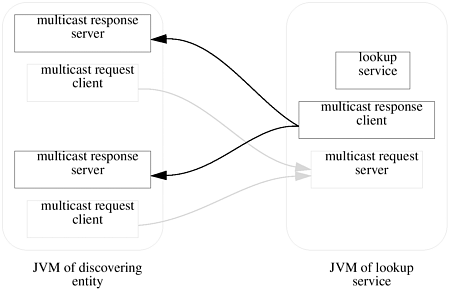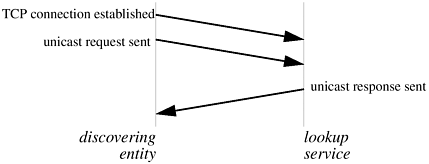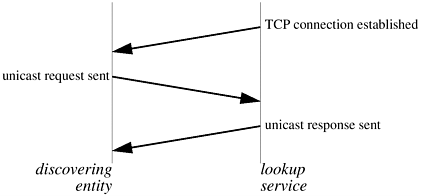DJ.2. The Discovery Protocols
There are three closely related discovery protocols: one is used to discover one or more lookup services on a local area network (LAN), another is used to announce the presence of a lookup service on a local network, and the last is used to establish communications with a specific lookup service over a wide-area network (WAN).
DJ.2.1. Protocol Roles
The multicast discovery protocols work together over time. When an entity is initially started, it uses the multicast request protocol to actively seek out nearby lookup services. After a limited period of time performing active discovery in this way, it ceases using the multicast request protocol and switches over to listening for multicast lookup announcements via the multicast announcement protocol.
DJ.2.2. The Multicast Request Protocol
The multicast request protocol allows an entity that has just been started, or that needs to provide browsing capabilities to a user, to actively discover nearby lookup services.
DJ.2.2.1. Protocol Participants
Several components take part in the multicast request protocol. Of these, two run on an entity that is performing multicast requests, and two run on the entity that listens for such requests and responds.
On the requesting side live the following components:
A multicast request client performs multicasts to discover nearby lookup services.
A multicast response server listens for responses from those lookup services.
These components are paired; they do not occur separately. Any number of pairs of such components may coexist in a single JVM at any given time.
The lookup service houses the other two participants:
A multicast request server listens for incoming multicast requests.
A multicast response client responds to callers, passing each a proxy that allows it to communicate with its lookup service.
Although these components are paired, as on the client side, only a single pair will typically be associated with each lookup service.
These local pairings apart, the remote client/server pairings should be clear from the above description and the diagram of protocol participants in Figure DJ.2.1.
Figure DJ.2.1. Multicast Request Protocol Participants

DJ.2.2.2. The Multicast Request Service
The multicast request service is not based on Java RMI; instead, it makes use of the multicast datagram facility of the networking transport layer to request that lookup services advertise their availability to a requesting host. In a TCP/IP environment the network protocol used is multicast UDP. Request datagrams are encoded as a sequence of bytes, using the data and object serialization facilities of the Java programming language to provide platform independence.
DJ.2.2.3. Request Packet Format
A multicast discovery request packet body must:
Be 512 bytes in size or less, in order to fit into a single UDP datagram
Encapsulate its parameters in a platform-independent manner
Be straightforward to encode and decode
Accordingly, we define the packet format to be a contiguous series of bytes as would be produced by a java.io.DataOutputStream object writing into a java.io.ByteArrayOutputStream object. The contents of the packet, in order of appearance, are illustrated by the following fragment of pseudocode which generates the appropriate byte array:
int protoVersion; // protocol version
int port; // port to contact
java.lang.String[] groups; // groups of interest
net.jini.core.lookup.ServiceID[] heard; // known lookups
java.io.ByteArrayOutputStream byteStr =
new java.io.ByteArrayOutputStream();
java.io.DataOutputStream objStr =
new java.io.DataOutputStream(byteStr);
objStr.writeInt(protoVersion);
objStr.writeInt(port);
objStr.writeInt(heard.length);
for (int i = 0; i < heard.length; i++) {
heard[i].writeBytes(objStr);
}
objStr.writeInt(groups.length);
for (int i = 0; i < groups.length; i++) {
objStr.writeUTF(groups[i]);
}
byte[] packetBody = byteStr.toByteArray(); // the final result To elaborate on the roles of the variables above:
The protoVersion variable contains an integer that indicates the version of the discovery protocol. This will permit interoperability between different protocol versions. For the current version of the discovery protocol, protoVersion must have the value 1.
The port variable contains the TCP port respondents must connect to in order to continue the discovery process.
The groups variable contains a set of strings (organized as an array) naming the groups the entity wishes to discover. This set may be empty, which indicates that all lookup services are being looked for.
The heard variable contains a set of net.jini.core.lookup.ServiceID objects (organized as an array) that identify lookup services from which this entity has already heard and that do not need to respond to this request.
The packetBody variable contains the marshalled discovery request in a form that is suitable for putting into a datagram packet or writing to an output stream.
The table below illustrates the contents of a multicast request packet body.
| Count | Serialized Type | Description |
|---|---|---|
| 1 | int | protocol version |
| 1 | int | port to connect to |
| 1 | int | count of lookups heard |
| variable | net.jini.core.lookup.ServiceID | lookups heard |
| 1 | int | count of groups |
| variable | java.lang.String | groups |
If the size of the packet body should exceed 512 bytes, the set of lookups from which an entity has heard must be left incomplete in the packet body, such that the size of the packet body will come to 512 bytes or less. How this is done is not specified. It is not permissible for implementations to simply truncate packets at 512 bytes.
Similarly, if the number of groups requested causes the size of a packet body to exceed 512 bytes, implementations must perform several separate multicasts, each with a disjoint subset of the full set of groups to be requested, until the entire set has been requested. Each request must contain the largest set of responses heard that will keep the size of the request below 512 bytes.
DJ.2.2.4. The Multicast Response Service
Unlike the multicast request service, the multicast response service is a normal TCP-based service. In this service the multicast response client contacts the multicast response server specified in a multicast request, after which unicast discovery is performed. The multicast response server to contact can be determined by using the source address of the request that has been received, along with the port number encapsulated in that request.
The only difference between the unicast discovery performed in this instance and the normal case is that the entity being connected to initiates unicast discovery, not the connecting entity. An alternative way of looking at this is that in both cases, once the connection has been established, the party that is looking for a lookup service proxy initiates unicast discovery.
DJ.2.3. Discovery Using the Multicast Request Protocol
Now we describe the discovery sequence for local area network (LAN)-based environments that use the multicast request protocol to discover one or more djinns.
DJ.2.3.1. Steps Taken by the Discovering Entity
The entity that wishes to discover a djinn takes the following steps:
It establishes a multicast request client, which will send packets to the well-known multicast network endpoint on which the multicast request service operates.
It establishes a TCP server socket that listens for incoming connections, over which the unicast discovery protocol is used. This server socket is the multicast response server socket.
It creates a set of net.jini.core.lookup.ServiceID objects. This set contains service IDs for lookup services from which it has already heard, and is initially empty.
It sends multicast requests at periodic intervals. Each request contains connection information for its multicast response server, along with the most recent set of service IDs for lookup services it has heard from.
For each response it receives via the multicast response service, it adds the service ID for that lookup service to the set it maintains.
The entity continues multicasting requests for some period of time. Once this point has been reached, it unexports its multicast response server and stops making multicast requests.
If the entity has received sufficient references to lookup services at this point, it is now finished. Otherwise, it must start using the multicast announcement protocol.
The interval at which requests are performed is not specified, though an interval of five seconds is recommended for most purposes. Similarly, the number of requests to perform is not mandated, but we recommend seven. Since requests may be broken down into a number of separate multicasts, these recommendations do not pertain to the number of packets to be sent.
DJ.2.3.2. Steps Taken by the Multicast Request Server
The system that hosts an instance of the multicast request service takes the following steps:
It binds a datagram socket to the well-known multicast endpoint on which the multicast request service lives so that it can receive incoming multicast requests.
When a multicast request is received, the discovery request server may use the service ID set from the entity that is sending requests to determine whether it should respond to that entity. If its own service ID is not in the set, and any of the groups requested exactly matches any of the groups it is a member of or the set of groups requested is empty, it must respond. Otherwise, it must not respond.
If the entity must be responded to, the request server connects to the other party’s multicast response server using the information provided in the request, and provides a lookup service registrar using the unicast discovery protocol.
DJ.2.3.3. Handling Responses from Multiple Djinns
What happens when there are several djinns on a network, and calls to an entity’s discovery response service are made by principals from more than one of those djinns, will depend on the nature of the discovering entity. Possible approaches include the following:
If the entity provides a finder-style visual interface that allows a user to choose one or more djinns for their system to join, it should loop at step 4 in section DJ.2.3.1, and provide the ability to:
Display the names and descriptions of the djinns it has found out about
Allow the user to select zero or more djinns to join
Continue to dynamically update its display, until the user has finished their selection
Attempt to join all of those djinns the user selected
On the other hand, if the behavior of the entity is fully automated, it should follow the join protocol described in Section DJ.3 “The Join Protocol”.
DJ.2.4. The Multicast Announcement Protocol
The multicast announcement protocol is used by Jini lookup services to announce their availability to interested parties within multicast radius. Participants in this protocol are the multicast announcement client, which resides on the same system as a lookup service, and the multicast announcement server, at least one instance of which exists on every entity that listens for such announcements.
The multicast announcement client is a long-lived process; it must start at about the same time as the lookup service itself and remain running as long as the lookup service is alive.
DJ.2.4.1. The Multicast Announcement Service
The multicast announcement service uses multicast datagrams to communicate from a single client to an arbitrary number of servers. In a TCP/IP environment the underlying protocol used is multicast UDP.
Multicast announcement packets are constrained by the same requirements as multicast request packets. The fields in a multicast announcement packet body are as follows:
| Count | Serialized Type | Description |
|---|---|---|
| 1 | int | protocol version |
| 1 | java.lang.String | host for unicast discovery |
| 1 | int | port to connect to |
| 1 | net.jini.core.lookup.ServiceID | service ID of originator |
| 1 | int | count of groups |
| variable | java.lang.String | groups represented by originator |
The fields have the following purposes:
The protocol version field provides for possible future extensions to the protocol. For the current version of the multicast announcement protocol this field must contain the value 1. This field is written as if using the method java.io.DataOutput.writeInt.
The host field contains the name of a host to be used by recipients to which they may perform unicast discovery. This field is written as if using the method java.io.DataOutput.writeUTF.
The port field contains the TCP port of the above host at which to perform unicast discovery. This field is written as if using the method java.io.DataOutput.writeInt.
The service ID field allows recipients to keep track of the services from which they have received announcements so that they will not need to unnecessarily perform unicast discovery. This field is written as if using the method net.jini.core.lookup.ServiceID.writeBytes.
The count field indicates the number of groups of which the given lookup service is a member. This field is written as if using the method java.io.DataOutput.writeInt.
This is followed by a sequence of strings equal in number to the count field, each of which is a group that the given lookup service is a member of. Each string is written as if using the method java.io.DataOutput.writeUTF.
If the size of the set of groups represented by a lookup service causes the size of a multicast announcement packet body to exceed 512 bytes, several separate packets must be multicast, each with a disjoint subset of the full set of groups, such that the full set of groups is represented by all packets.
DJ.2.4.2. The Protocol
The details of the multicast announcement protocol are simple. The entity that runs the lookup service takes the following steps:
It constructs a datagram socket object, set up to send to the well-known multicast endpoint on which the multicast announcement service operates.
It establishes the server side of the unicast discovery service.
It multicasts announcement packets at intervals. The length of the interval is not mandated, but 120 seconds is recommended.
An entity that wishes to listen for multicast announcements performs the following set of steps:
It establishes a set of service IDs of lookup services from which it has already heard, using the set discovered by using the multicast request protocol as the initial contents of this set.
It binds a datagram socket to the well-known multicast endpoint on which the multicast announcement service operates and listens for incoming multicast announcements.
For each announcement received, it determines whether the service ID in that announcement is in the set from which it has already heard. If so, or if the announcement is for a group that is not of interest, it ignores the announcement. Otherwise, it performs unicast discovery using the host and port in the announcement to obtain a reference to the announced lookup service, and then adds this service ID to the set from which it has already heard.
DJ.2.5. Unicast Discovery
While workgroup-level devices need to be able only to discover local djinns, a user might need to be able to access services in djinns that may be dispersed more widely (for example in offices in other cities or on other continents). To this end, the software at the user’s fingertips must be able to obtain a reference to the lookup service of a remote djinn. This is done using the unicast discovery protocol.
The unicast Jini discovery protocol uses the underlying reliable unicast transport protocol provided by the network instead of the unreliable multicast transport. In the case of IP-based networks this means that the unicast discovery protocol uses unicast TCP instead of multicast UDP.
DJ.2.5.1. The Protocol
The unicast discovery protocol is a simple request-response protocol.
If an entity wishes to obtain a reference to a given djinn, the entity has a lookup locator object for that djinn and makes a TCP connection to the host and port specified by that lookup locator. It sends a unicast discovery request (see below), to which the remote host responds.
If a lookup service is responding to a multicast request, the request to which it is responding contains the address and port to respond to, and it makes a TCP connection to that address and port. The respondee sends a unicast discovery request, and the lookup service responds with a proxy.
The protocol diagram in Figure DJ.2.2 illustrates the flow when unicast discovery is initiated by a discovering entity.
Figure DJ.2.2. Unicast Discovery Initiated by a Discovering Entity

The protocol diagram in Figure DJ.2.3 indicates the flow when a lookup service initiates unicast discovery in response to a multicast request.
Figure DJ.2.3. Unicast Discovery Initiated by a Lookup Service

DJ.2.5.2. Request Format
A discovery request consists of a stream of data as would be obtained by writing code similar to the following:
int protoVersion; // protocol version
java.io.ByteArrayOutputStream byteStr =
new java.io.ByteArrayOutputStream();
java.io.DataOutputStream objStr =
new java.io.DataOutputStream(byteStr);
objStr.writeInt(protoVersion);
byte[] requestBody = byteStr.toByteArray(); // final result The protoVersion variable above must have a value of 1 for the current version of the unicast discovery protocol. The requestBody variable contains the discovery request as would be sent to the unicast discovery request service.
DJ.2.5.3. Response Format
The response to the above request consists of a stream of data as would be obtained by writing code similar to the following:
net.jini.core.lookup.ServiceRegistrar reg;
String[] groups; // groups registrar will respond with
java.rmi.MarshalledObject obj =
new java.rmi.MarshalledObject(reg);
java.io.ByteArrayOutputStream byteStr =
new java.io.ByteArrayOutputStream();
java.io.ObjectOutputStream objStr = new
java.io.ObjectOutputStream(byteStr);
objStr.writeObject(obj);
objStr.writeInt(groups.length);
for (int i = 0; i < groups.length; i++) {
objStr.writeUTF(groups[i]);
}
byte[] responseBody = byteStr.toByteArray(); // final result When the discovering entity receives this data stream, it can deserialize the MarshalledObject it has been sent and use the get method of that object to obtain a lookup service registrar for that djinn.
